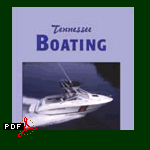
Online
Licensing
|
CARBON MONOXIDE AND
OTHER SAFETY HAZARDS
Each year, boaters are injured or killed by carbon monoxide. Most incidents occur on
older boats and within the cabin or other enclosed areas. Exhaust leaks, the leading cause of death
by carbon monoxide, can allow carbon monoxide to migrate throughout the boat and into enclosed
areas. New areas of concern are the rear deck near the swim platform with the generator or engines
running and teak surfing or dragging behind a slow moving boat. Regular maintenance and proper boat
operation can reduce the risk of injury from carbon monoxide.
Facts
- Carbon monoxide is a potentially deadly gas produced any time that a
carbon-based fuel, such as gasoline, propane, charcoal, or oil, burns. Sources on your boat
include gasoline engines, generators, cooking ranges, and space and water heaters. Cold or
poorly tuned engines produce more carbon monoxide than warm, properly tuned engines.
- Carbon monoxide is colorless, odorless, and tasteless, and mixes evenly with
the air. It enters your bloodstream through the lungs and displaces the oxygen your body needs.
Early symptoms of carbon monoxide poisoning - irritated eyes, headache, nausea, weakness, and
dizziness - are often confused with seasickness or intoxication. Prolonged exposure to low
concentrations or very short exposure to high concentrations can lead to death.
- All carbon monoxide poisonings are preventable!
Avoid the Following Death Zones
- Swimming near or under the back deck or swim platform. Carbon monoxide from exhaust pipes of inboard engines, outboard engines and generators build up inside and outside the boat in areas near exhaust vents. Stay away from these exhaust vent areas and do not swim in these areas when the motor or generator is operating. On calm days, wait at least 15 minutes after the motor or generator has been shut off before entering these areas. Never enter an enclosed area under a swim platform where exhaust is vented, not even for a second. It only takes one or two breaths of the air in this "death chamber" for it to be fatal.
- Teak surfing, dragging and water skiing within 20 feet of a moving watercraft can be fatal.
Did You Know?
- Blockage of exhaust outlets can cause carbon monoxide to accumulate in the cabin and cockpit area - even when hatches, windows, portholes, and doors are closed.
- Exhaust from another vessel that is docked, beached, or anchored alongside your
boat can emit poisonous carbon monoxide gas into the cabin and cockpit of your boat. Even with
properly vented exhaust, your boat should be a minimum of 20 feet from the nearest boat that is
running a generator or engine.
- Slow speeds or idling in the water can cause carbon monoxide gas to accumulate
in the cabin, cockpit, bridge, and aft deck, even in an open area. A tailwind can also increase
accumulation.
- The "station wagon effect," or backdrafting can cause carbon monoxide
to accumulate inside the cabin, cockpit and bridge when operating the boat at a high bow angle,
with improper or heave loading or if there is an opening which draws in exhaust. This effect can
also cause carbon monoxide to accumulate inside the cabin, cockpit, aft deck, and bridge when
protective coverings are used and the boat is underway.
What to Do
- Educate family and friends about carbon monoxide so they are aware of what the early poisoning signs are.
- If your boat has rear-vented generator exhaust, check with the boat
manufacturer for possible recall or reroute the exhaust to a safe area.
- Assign an adult to watch when anyone is swimming or playing in the water.
- Schedule regular engine and exhaust system maintenance inspections by
experienced and trained technicians.
- Keep forward-facing hatches open, even in inclement weather, to allow fresh air
circulation in living spaces. When possible, run the boat so that prevailing winds will help
dissipate the exhaust.
- Do not confuse carbon monoxide poisoning with seasickness, intoxication or heat
stress. If someone on board complains of irritated eyes, headache, nausea, weakness or
dizziness, immediately move the person to fresh air, investigate the cause and take corrective
action. Seek medical attention if necessary.
- Install a carbon monoxide detector in each accommodation space on your boat.
Test the operation of each detector before each trip.
Other Life Threatening Hazards
Propeller Safety: Protect those toes, feet, legs, and lives. Be aware of your
boat's "danger zone." Swim platforms, ladders, and slides are all located in the rear of
the boat where the propeller is lurking right under the water. Use caution when swimming, loading,
or jumping off the rear of boats. Turn the engine off when people are swimming near the boat. On
larger boats, have someone to visually check the stern area for persons in the water before placing
engines in reverse.
Electricity and Boats: All power cords used on boats should be rated suitable for Marine Use, or UL-Marine listed. Never use ordinary "outdoor-use" extension cords to provide electrical shore power to the boats. Never leave a shore power cord on the dock with only the plug end connected. A live cord end is dangerous, especially if it accidentally falls into the water. When AC current leaks out of the AC system and reaches any grounded item on the boat that is in contact with the water then this leakage current will spread out on the water and anyone swimming in the field will be subject to electrical shock.
|



|

